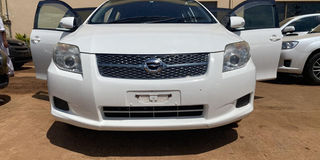If I avoid traffic jam, my Fielder’s fuel lasts

What you need to know:
The Toyota Fielder 2008 model has endeared itself to motorists primarily because of its modest fuel consumption, writes Roland D. Nasasira.
Joseph Otim
I have driven a number of cars but the Toyota Fielder offers more driving comfort compared to other station wagons. Like most cars, it can be used as a daily car regardless of whether you are driving upcountry or within the city.
Its performance is not the best but you can rely on it to take you wherever you want. For instance, its ground clearance allows you drive through any kind of terrain. On the highway, it has capacity to give you 15km using one litre of fuel. This entirely depends on the weight of your acceleration. The heavier the foot, the more fuel it will burn.
In urban areas, with slow moving traffic, it will give you seven to 10km using one litre of fuel. It runs on a 1500cc engine size and this makes it one of the most economical cars when it comes to fuel consumption.
Secondly, it has strong suspension that when you hit a pothole or quadruple or triple road bumps unknowingly, you will not feel any discomfort.
Like any other car, the Fielder is more stable when loaded. However, I do not overload it to avoid spending more on fuel. It has to be average weight.
Like fuel consumption, service and maintenance of the Fielder is also affordable. To keep it in the best roadworthy condition, I service it after 5,000km as recommended on the service leaflet. This normally takes me approximately four months. But when I notice a change in consumption or start noticing unusual sounds, for example from the engine, I have the mechanic inspect it for any faults.
On average, I spend approximately Shs250,000 on major service. When you take care of the Fielder well, it also serve you well.
Irene Kalungi
Before buying the Toyota Fielder, I owned a Toyota Spacio. Unlike the Spacio, the Fielder is more spacious much as the two cars have the same seating capacity. However, the amount of luggage that goes into the trunk of the Toyota Fielder cannot go into that of the Spacio and this is one of the aspects I like about the Fielder.
I live in Namugongo and drive to work in the city centre ( a distance of about 12.5km) daily. For this journey, I spend approximately Shs120,000 on fuel in a week because of unpredictable traffic jam along the way. However, this cost greatly reduces to about Shs100,000 when I leave home and work early to beat the traffic jam.
The Fielder is a car suitable for a small family of six people. The rear seats can accommodate up to four passengers, especially children. I normally carry my documents home and its storage pockets, especially on the door sides makes protecting my documents easy.
I have been to the garage twice since I bought the car. On each of these visits, I have not spent more than Shs150,000. Sometimes, service is not needed but I listen out for any changes that might indicate a fault and this is when I take the car to the garage. I have only replaced the brake pads and the engine oil twice in 18 months.
The one downside to the Fielder is that it does not have enough legroom for passengers, especially those at the rear.
Ian Kaheru
I love my Toyota Fielder because it makes my journeys upcountry to Ntungamo District worthwhile. With its friendly fuel consumption, its 50-litre fuel tank capacity that costs approximately Shs200,000 to fill can take me home without need to top up on the way. Depending on how I accelerate, it can give me 10 to 15km using one litre of fuel on the highway.
I also love the fact that if you are of a short stature, you can adjust the driver’s seat by pumping one of the knobs on the seat sides until you reach your preferred driving position. It is an all-wheel drive car that neither gets stuck in mud, sand or when you park in grass.
For music lovers, it comes fitted with enough speakers on all the doors, with a provision of fixing an external speaker in the trunk if you love amplified music. The manufacturer’s inbuilt radio system limits you on the number of stations you can tune into but it can be replaced with one that gives you options for many stations.
It also has proper braking efficiency. This is because of its weight that not only allows you brake efficiently when there is need but also contributes to its stability.
On average, I spend Shs200,000 on service and maintenance. This caters for things such as engine oil, brake pads, transmission fluid, wiper, air filters and a few other parts. This is after about five months since I do not use the car daily. When it comes to fuel, I spend approximately Shs300,000 every month.




